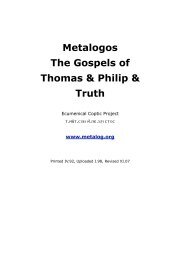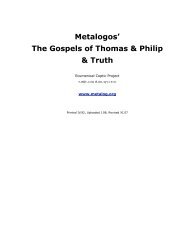Andrew Louth - Syriac Christian Church
Andrew Louth - Syriac Christian Church
Andrew Louth - Syriac Christian Church
You also want an ePaper? Increase the reach of your titles
YUMPU automatically turns print PDFs into web optimized ePapers that Google loves.
26 INTRODUCTION<br />
struggle is the reconciling power of the love of God—the love of God that<br />
is the eternal life of the Trinity of Father, Son and Holy Spirit and that<br />
is manifest and reaches out to us in the assumption of a human life by<br />
the Son in the Incarnation. This was beyond human understanding,<br />
but not beyond human misunderstanding: and it was to protect<br />
against human misunderstanding of what the Fathers called theology<br />
(meaning the doctrine of the Trinity) and ‘economy’ (meaning God’s<br />
dealing with humankind—pre-eminently in the Incarnation, but<br />
including creation and revelation through Scripture and reconciling<br />
activity in the Sacraments) that what we call the ‘theological tradition’<br />
had been developed by the Fathers and the Councils.<br />
The theological tradition that Maximus had received and sought to<br />
interpret faithfully—and which, in the Monothelite controversy, he<br />
played a decisive role in forming—was composed of several strands.<br />
The most obvious—because so many of Maximus’ scholia directly deal<br />
with passages from their writings—is the Cappadocian tradition, that<br />
is the theological doctrine of the three fourth-century bishops from<br />
Cappadocia—Basil of Caesarea, Basil’s long-standing friend, Gregory<br />
of Nazianzus (though this was the episcopal see of his father: he was<br />
Bishop of, successively, Sasima and briefly Constantinople), and<br />
Basil’s younger brother, Gregory of Nyssa. It may be an<br />
oversimplification to speak of the ‘Cappadocian Fathers’ (it is a<br />
modern habit), but for Maximus what it means overwhelmingly is the<br />
teaching of St Gregory of Nazianzus, ‘the Theologian’. 24 The evidence<br />
of his engagement with the Theologian is mainly found in his<br />
Difficulties. On the face of it, this is ambiguous evidence for Gregory’s<br />
positive influence on Maximus: it is more directly evidence of the<br />
difficulty Maximus found in interpreting him. What kind of difficulties<br />
Maximus faced is too complex a question to go into here. 25 But some of<br />
the more theological problems he had with Gregory can be stated<br />
simply. Part of Maximus’ problem with Gregory was the problem of<br />
‘Origenism’. Gregory, like many fourth-century theologians, had been<br />
deeply influenced by Origen: in their youth, Basil and Gregory<br />
Nazianzen had compiled a florilegium from Origen’s works, called the<br />
Philokalia. It was precisely because of his authority as ‘the Theologian’<br />
that Gregory was a favourite author among those monks inclined to<br />
Origenism. Other problems had to do with his Christology: that we<br />
shall come to soon. But the Cappadocian Fathers—or Gregory—did<br />
provide answers as well as problems, not least their clarification of the<br />
ontological language (language concerning being) to be used in<br />
relation to God: they thus contributed towards the ‘Chalcedonian logic’<br />
that Maximus brought to perfection. But Maximus was also indebted<br />
to the youngest Cappadocian Father, St Gregory of Nyssa. This<br />
Gregory was probably the most brilliant speculative thinker of the




